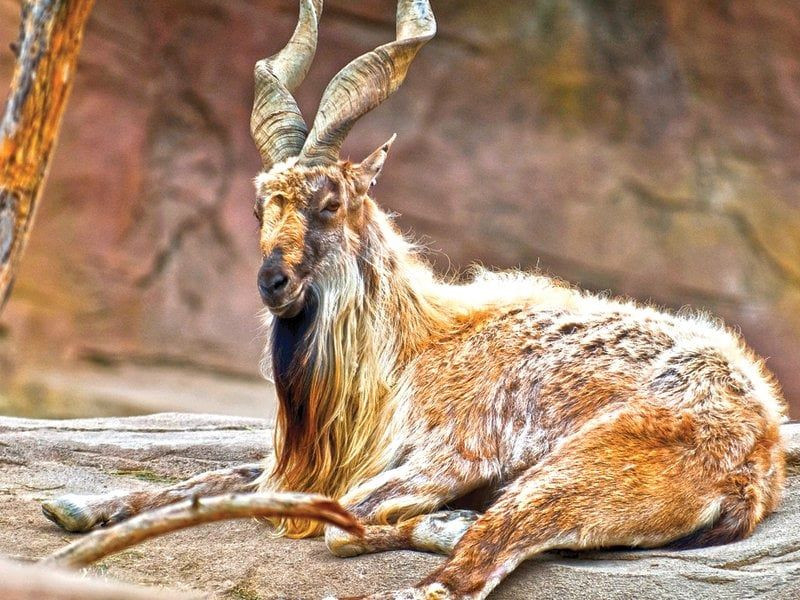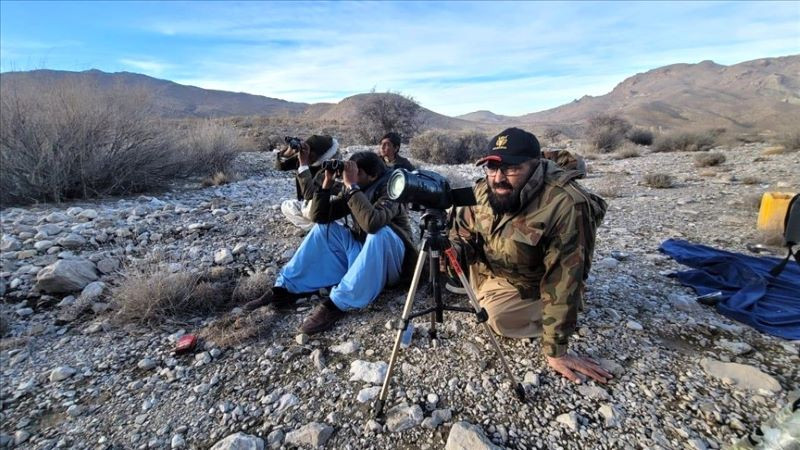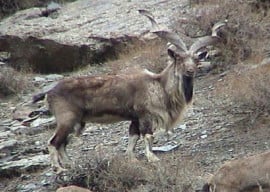
Asadullah Bazai, Pakistan’s former national shooting champion and a veteran hunter, is on a mission to save the country’s rare Sulaiman markhor, a straight-horned goat that was once on the verge of extinction due to extensive hunting and poaching.
Bazai, 55, and his team have devoted a great deal of time — and a good deal of money — to the preservation of the rare species in Balochistan.
The Sulaiman markhor is a sub-species of the markhor — Pakistan’s national animal — and is endemic to Asia.
In Balochistan, the mountainous regions of Torghar and Takatu are the two major habitats of the animal, while it is also found in small numbers in the mountains and forests of Ziarat, Sherani and Zhob districts.
Bazai, a father of five, who has represented Pakistan in several international shooting events, gave up hunting and launched the mission to save the Sulaiman markhor in 2002.
His team, comprising several former amateur hunters and wildlife photographers, operates across Takatu range, which is located in the northeast of Quetta and spans over 150 kilometres.

In 2002, Bazai met with some Hungarian rifle shooters at a competition in Karachi who changed his mind about hunting animals.
“It was a life-changing moment that transformed me from a hunter to a conservator. One of them told me don’t shoot live animals with a rifle, shoot them with a camera,” he told Anadolu.
When he launched his campaign in 2002, there were only a few dozen Sulaiman markhors left in the Takatu range.
Read: PM for protecting Markhor, other species
Current estimates, according to Bazai and other wildlife experts, put the animal’s population at around 2,000, while a 2023 survey by the Balochistan Wildlife Department placed the number in the Takatu range at 1,400.
“We have involved local communities in our campaign and convinced them to not kill the animal, and also to stop hunters from doing that,” Bazai added.
‘Stable’ numbers
In comparison to other species, the Sulaiman markhor lives in a clearer and drier climate at an altitude of between 2,290 to 2,745 metres.
Years of concerted efforts, including greater community involvement and a sustainable trophy hunting programme, have helped bring the animal’s population to the “stable” category.
A long-term project launched in the 1980s by Balochistan’s Forest Department in collaboration with a tribal chief and wildlife lover, Mir Naseer Khan, began yielding results in early 2000.
“When that project was launched, the total population of Sulaiman markhor was alarmingly low, just less than 100,” Tahir Rasheed, a Quetta-based wildlife expert, told Anadolu.
“It is the combined effort of the forest department and the tribal chief that eventually brought the animal out of danger and its population in the thousands,” added Rasheed, a former official with the World Wildlife Fund for Nature (WWF), who is currently serving as head of the Balochistan Rural Support Programme.
In the last survey conducted a decade ago, in which Rasheed himself participated, the population of Sulaiman markhor was recorded at over 3,000.
Current estimates suggest that their number is between 4,500 and 5,000, said Arz Mohammad, a conservator at the Balochistan Wildlife Department.
Speaking to Anadolu, he said international wildlife organisations still categorised the Sulaiman markhor as an endangered species, but considering the gradual and significant increase in its population over the years, it could now be classified as “stable”.
Unlike other rare animals, the Sulaiman markhor enjoys a diverse habitat across the sprawling province.
Together with Takatu, the mountainous range of Torghar, located some 160km from Quetta, makes up the animal’s largest habitat, hosting 95 per cent of its total population.
The Torghar range is estimated to have around 3,500 Sulaiman markhors.
These habitats lie hundreds of kilometres from each other, which reduces the risk of transmission of diseases among the two populations in case of an outbreak, according to Rasheed.
Another thing that helped increase the animal’s population over the years has been a trophy hunting programme, he said.
For the 2023-24 hunting season, the Balochistan government granted a permit to hunt a Sulaiman markhor for a record $245,000, one of the highest-priced permits in the world.
A total of four licenses are issued annually to hunt Sulaiman markhor.
The remaining three permits were granted for $220,000, $218,000 and $210,000, according to official documents.
The government uses the money to support local communities with initiatives such as building schools, mosques, health centres and even providing scholarships to students.
About 80pc of the amount generated through the hunting license programme, launched in early 2000, is spent on local communities, while the remainder goes to the national exchequer.
Threats still lurking
Pakistan is famous for the markhor, which is distinguished by its nimble and sure-footed nature as well as its long winter coat and massive spiral horns, which can grow to more than 1.5m in length for males.
Locally, the goats are categorised as Astor, Kashmiri, Sulaiman and Chiltan markhors.
Globally, Astor and Kashmiri markhors are classified as flare-horned, while Sulaiman and Chilton markhors are categorised as straight-horned.
Despite a significant increase in its population, the Sulaiman markhor is still near-endangered due to a host of threats.
“Climate change, increasing deforestation, illegal hunting and illegal wildlife trade are the major challenges,” said Mayen Khan, a wildlife expert and member of Bazai’s team.
Speaking to Anadolu, he said illegal hunting and poaching of Sulaiman markhor, including babies, was still happening despite government and community efforts.
A young markhor is sold for between Rs100,000 and 200,000 ($358 and $717), a price that encourages many locals to hunt the rare animals, according to Khan, who is also a professional wildlife photographer.
Under local laws, hunting female or young markhor is prohibited, carrying a six-year prison sentence, a fine of up to Rs150,000 ($538) or both.
But these laws are rarely enforced, and the mostly wealthy and influential violators usually go scot-free.
“Firstly, the penalty for illegal hunting has to be much higher, and then we have to ensure that it is implemented across the board, for any and all,” Khan emphasised.





















COMMENTS
Comments are moderated and generally will be posted if they are on-topic and not abusive.
For more information, please see our Comments FAQ